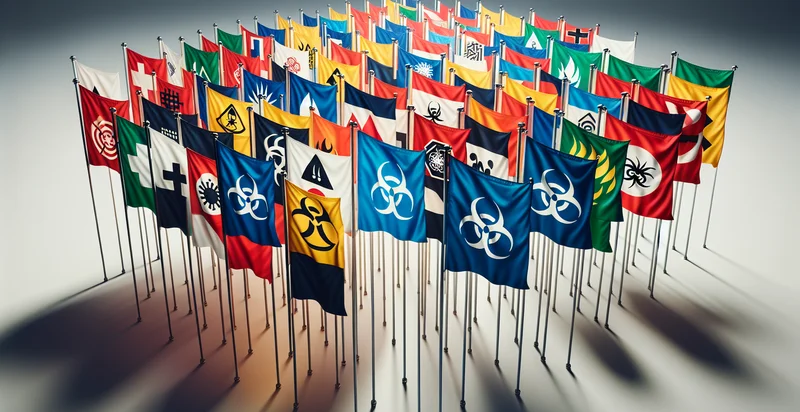Identify emergency mgmt flags
using AI
Below is a free classifier to identify emergency mgmt flags. Just upload your image, and our AI will predict what type of emergency management flags are present - in just seconds.

Contact us for API access
Or, use Nyckel to build highly-accurate custom classifiers in just minutes. No PhD required.
Get started
import nyckel
credentials = nyckel.Credentials("YOUR_CLIENT_ID", "YOUR_CLIENT_SECRET")
nyckel.invoke("emergency-mgmt-flags-identifier", "your_image_url", credentials)
fetch('https://www.nyckel.com/v1/functions/emergency-mgmt-flags-identifier/invoke', {
method: 'POST',
headers: {
'Authorization': 'Bearer ' + 'YOUR_BEARER_TOKEN',
'Content-Type': 'application/json',
},
body: JSON.stringify(
{"data": "your_image_url"}
)
})
.then(response => response.json())
.then(data => console.log(data));
curl -X POST \
-H "Content-Type: application/json" \
-H "Authorization: Bearer YOUR_BEARER_TOKEN" \
-d '{"data": "your_image_url"}' \
https://www.nyckel.com/v1/functions/emergency-mgmt-flags-identifier/invoke
How this classifier works
To start, upload your image. Our AI tool will then predict what type of emergency management flags are present.
This pretrained image model uses a Nyckel-created dataset and has 25 labels, including Civil Defense, Community Preparedness, Contingency Planning, Crisis Management, Disaster Management, Disaster Recovery, Disaster Relief, Emergency Communications, Emergency Operations Center and Emergency Planning.
We'll also show a confidence score (the higher the number, the more confident the AI model is around what type of emergency management flags are present).
Whether you're just curious or building emergency mgmt flags detection into your application, we hope our classifier proves helpful.
Related Classifiers
Need to identify emergency mgmt flags at scale?
Get API or Zapier access to this classifier for free. It's perfect for:
- Fraud Detection in Insurance Claims: The false image classification function can be employed by insurance companies to analyze submitted claims that include images. By identifying potentially fraudulent images—such as altered accident scenes or manipulated receipts—insurers can flag suspicious claims for further investigation, reducing financial losses.
- Social Media Content Monitoring: Organizations can implement the identifier to monitor images shared on social media platforms for emergency management flags. This can help identify false reports of emergencies, such as fake natural disaster incidents, allowing authorities to focus on real crises and manage public information more effectively.
- Disaster Response Coordination: Emergency response teams can utilize the classifier to evaluate images shared on platforms like Twitter or Facebook during disaster scenarios. By filtering out false or misleading images, responders can focus on genuine calls for help and deploy resources where they are truly needed, improving overall efficiency.
- Public Safety Campaigns: Government and non-profit organizations can leverage the identifier to evaluate images used in public safety campaigns. By ensuring that only accurate imagery is disseminated, these organizations can enhance the effectiveness of their messaging and build trust within the community while fighting misinformation.
- Automated Quality Control in Media: News agencies can integrate the false image classification function to verify images before publication. By identifying and flagging false images, media outlets can uphold journalistic integrity and prevent the spread of misinformation, ultimately maintaining audience trust.
- Security Threat Assessment: Security firms can use the classifier to process images from surveillance feeds or reports to identify threats marked by emergency management flags. This can aid in distinguishing between actual threats and benign activities, allowing for a more focused and timely response.
- Training for Emergency Services: The identifier can be incorporated into training modules for emergency services personnel. By using flagged images to create scenarios in training exercises, teams can learn to identify, assess, and respond to emergencies effectively while being aware of the challenges posed by false imagery in real-world situations.


